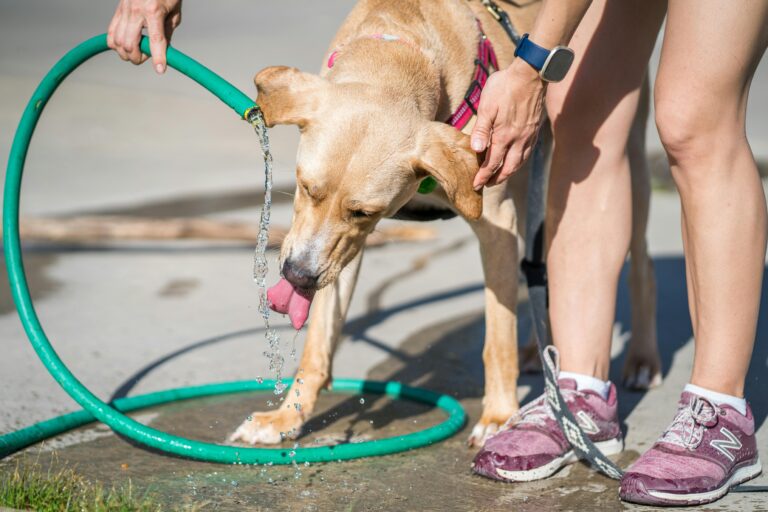French Bulldog’s Genius Heatwave Hack Has TikTok in Stitches
As we all look for ways to escape the heat, it turns out our four-legged friends are getting creative, too.
One hilarious French Bulldog has gone viral on TikTok after being caught cooling off in a basin of water. In the clip, shared by @frenchbulldog.l.ove, he adorable pup splashes around with his paws before climbing in for a well-earned soak. The video’s cheeky caption reads: “I almost got a heat stroke after walking for 10 minutes on a hot day. You should pay attention to the French guy in this hot season.”
Given how much this Frenchie is panting while in the basin, we have no doubts he indeed needed that soak. Watch the hilarious video below:
@frenchbulldog.l.ove I almost got a heat stroke after walking for 10 minutes on a hot day You should pay attention to the French guy in this hot season #FrenchBulldog #frenchie #cutedog#dogsoftiktok #pet #sunstroke #heatshock #fyp ♬ nhạc nền – French Bulldog Family
Heat Stroke In Dogs: Here’s Everything You Should Know
Summer often presents the perfect opportunity for us to tag our furry friends along to exciting outdoor activities. After all, who would want their dog to miss out on all the summer fun?

While the hot weather calls for unlimited family adventures, there’s one not-so-hidden danger you need to keep in mind as a dog owner: heat stroke.
You see, our four-legged besties don’t regulate their body temperature as effectively as our bodies do. While we’re fortunate to have sweat glands all over our bodies, dogs majorly rely on the sweat glands on their paw pads and noses to cool down. In addition, they also have to pant to dissipate the excess body heat. When it’s too hot, your dog’s natural methods of cooling down may not be as effective, putting them at risk of overheating, and ultimately, heat stroke.
Heat stroke is a potentially fatal heat-related illness that occurs when your dog’s body temperature rises to dangerous levels (way above their normal body temperature), and they’re unable to dissipate the excess heat.
“Heat stroke happens when a dog’s body can’t cope with an internal rise in temperature. Dogs are not as good at dealing with high temperatures as us, and can only sweat to cool down on areas not covered by fur, such as their paws and nose,” explain experts at RoundWood Vets.
At What Temperature Do Dogs Develop Heatstroke?

According to the Cornell University College of Veterinary Medicine, a dog’s normal body temperature ranges between 100.5 and 102.5 degrees Fahrenheit. Heat stroke occurs when your furry friend’s body temperature reaches 105 ℉ (or more).
Dogs are at a higher risk of developing heatstroke on warm days if they exercise excessively, go for long walks, if they’re left inside a hot car without ventilation, and if they’re left outdoors without ample shade and enough drinking water.
If left untreated, heat stroke causes significant organ damage, leading to death.
“As their body temperature rises, it damages their tissues and organs, making them unwell. In severe cases, heat stroke can cause their organs to fail and can lead to death,” reveal experts at RoundWood Vet.
While any dog can develop heat stroke in the face of high temperatures, dog breeds with extra-fluffy coats or short snouts (we see you, Pugs, Frenchies, and other brachycephalic breeds) are at a higher risk. In addition, overweight and senior dogs are more prone to heat stroke.
Heat Stroke Vs. Heat Exhaustion in Dogs: What’s the Difference?
Heat stroke and heat exhaustion in dogs are terms often used interchangeably. However, the two aren’t the same, according to experts from the Burlington Emergency & Veterinary Specialists.
In the simplest terms, heat exhaustion occurs when your dog’s body temperature rises slightly above their normal body temperature, but not to dangerous levels. If their body temperature continues rising, heat stroke sets in. Typically, the symptoms of heat exhaustion in dogs are less severe compared to heat stroke symptoms.
Common signs of heat exhaustion in dogs include:
- Prolonged panting
- Increased Lethargy
- Stumbling while walking
- Increased salivation
- Muscle tremors
- Rapid breathing
- Vomiting or diarrhea
When your dog starts showing signs of heat exhaustion, it’s important to try and cool them down immediately. You can achieve this by moving them to a shaded area, bringing them indoors and running the air conditioner, placing a wet towel on them (and changing this towel after some time), and offering them cool drinking water.
It’s advisable to still see the vet even after your dog’s symptoms improve, just to ensure they didn’t sustain any internal damage from heat exhaustion.
If your dog develops heat stroke, they’ll exhibit symptoms such as:
- Uncontrollable, noisy panting
- Heavy drooling
- Lack of coordination
- Unresponsiveness or confusion
- Excessive vomiting and diarrhea (may be bloody)
- Unusual gum color
- Seizures
- Collapse
Since heat stroke is a matter of life and death, you should rush your dog to the nearest veterinary hospital immediately for emergency care. The good news is, an affected dog can recover from heat stroke with appropriate treatment and care.
Expert Tips to Prevent Your Dog From Developing Heat Stroke During Hot Weather

While being familiar with the signs of heat exhaustion or heat stroke is crucial, what’s even more important is taking precautions to prevent these symptoms from occurring in the first place. Here are a few essential tips to prevent your dog from having a heat stroke, according to Dr. Meredith of Oak Park Pet Hospital:
- Ensure your dog has access to plenty of fresh drinking water and proper ventilation while indoors
- If you plan to walk your dog, do so when the sun isn’t at its peak, that is, early morning or late evening.
- Avoid taking your dog through intense exercises during hot weather, and give them plenty of rest breaks during these light exercise sessions.
- Always have fresh water in hand to cool your dog down as you walk them during summer.
- Never leave your dog unattended in a locked vehicle during hot days.
- Do not leave your dog outdoors for prolonged periods of time without ample shade.
- Avoid walking them on hot pavements. “If the pavement is too hot for your bare hand, it’s most likely too hot for your dog’s paws,” explains Dr. Meredith.
The three stages of heat exhaustion in dogs are:
- Heat Stress: This is the early stage where a dog starts to overheat. Symptoms may include heavy panting, increased heart rate, drooling, and seeking shade or cooler areas. It’s a warning sign that the dog is getting too hot and needs to be cooled down.
- Heat Exhaustion: If the dog isn’t cooled down during the heat stress phase, it can progress to heat exhaustion. Symptoms become more severe and may include excessive panting, lethargy, weakness, vomiting, and diarrhea. The dog’s body temperature is elevated, and immediate action is needed to cool the dog down.
- Heat Stroke: This is the most severe and life-threatening stage. The dog’s body temperature can rise above 104°F (40°C), and symptoms may include confusion, collapse, seizures, unresponsiveness, and even organ failure. Heat stroke is a medical emergency that requires immediate veterinary care.
Heat Stroke in Dogs FAQs
How hot is it too hot to walk your dog?
It’s advisable not to walk your dog when the sun is at its peak. During hot weather, experts recommend walking your dog in the early morning or late evening.
Heat exhaustion in dogs treatment at home
If your dog shows signs of heat exhaustion at home, consider taking measures to cool them down, such as bringing them indoors where there is proper ventilation or air conditioning, covering them with a cool towel (dipped in water), and giving them fresh drinking water.
How hot is it too hot to walk dogs on pavement?
Experts say if the ground or pavement feels too hot when you touch it with your bare hands, then it’s too hot to walk your dog on.
What is difference between Heat Stress and Heat Exhaustion in Dogs?
Heat stress and heat exhaustion in dogs are both conditions caused by excessive heat, but they differ in severity. Heat stress is an early warning sign that a dog is struggling to cope with rising temperatures. Symptoms may include excessive panting, drooling, increased heart rate, and restlessness. If not addressed, heat stress can progress to heat exhaustion, a more serious condition where the dog’s body temperature becomes dangerously high. During heat exhaustion, dogs may experience weakness, confusion, vomiting, diarrhea, and even collapse. Immediate action, such as cooling the dog down and seeking veterinary care, is crucial to prevent further escalation to heat stroke, which can be life-threatening.





